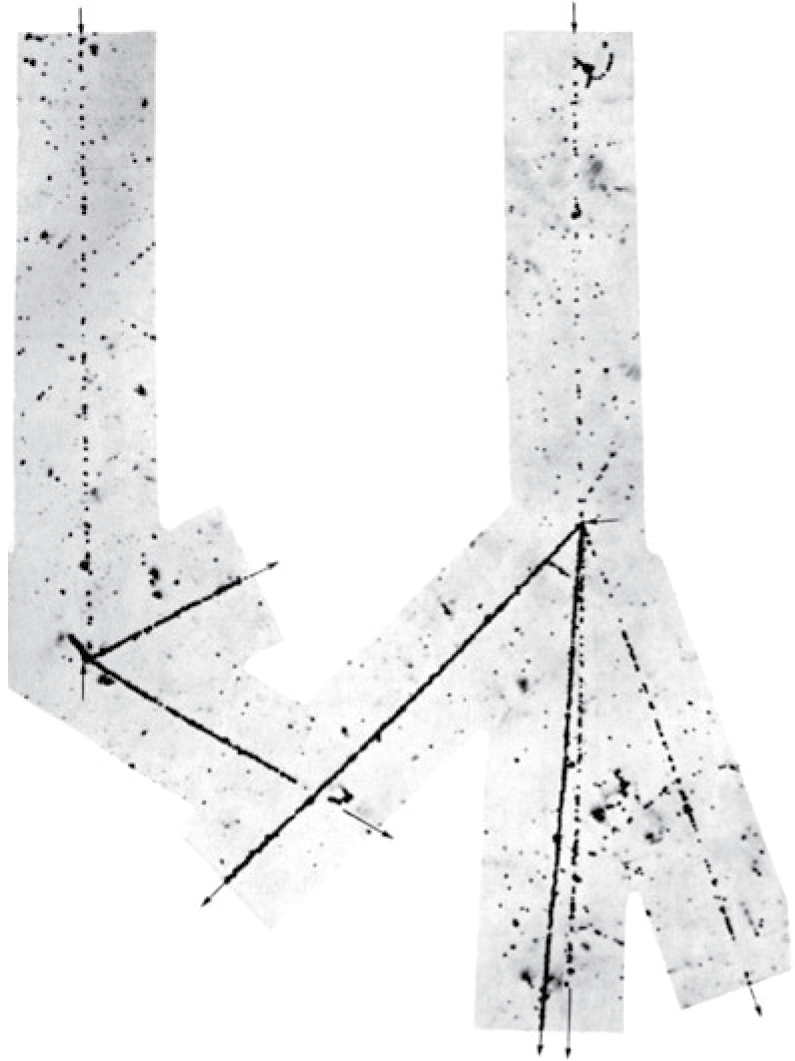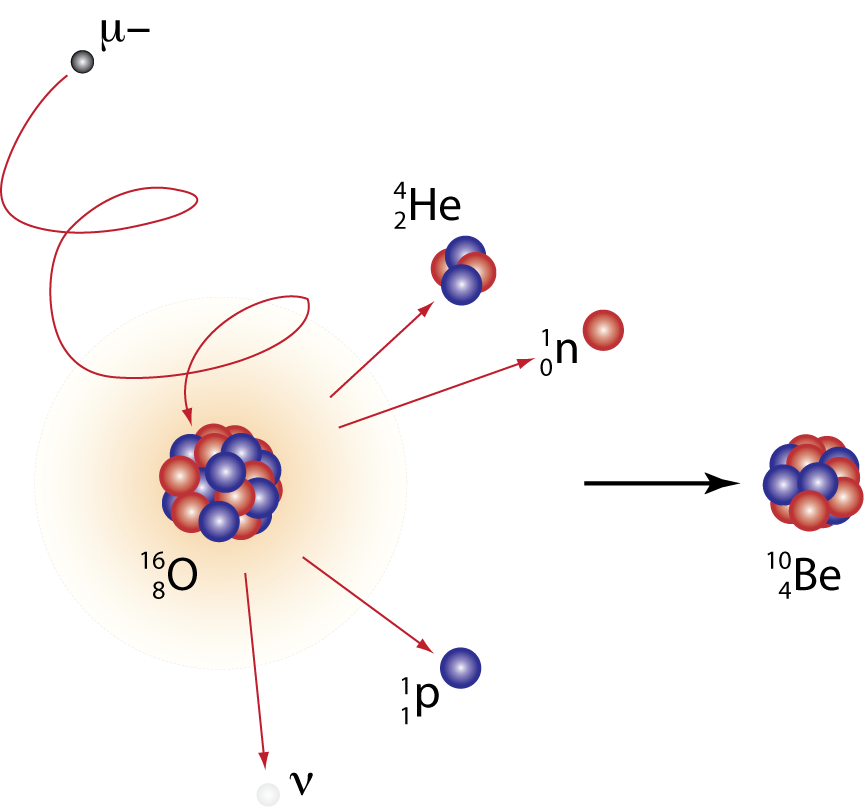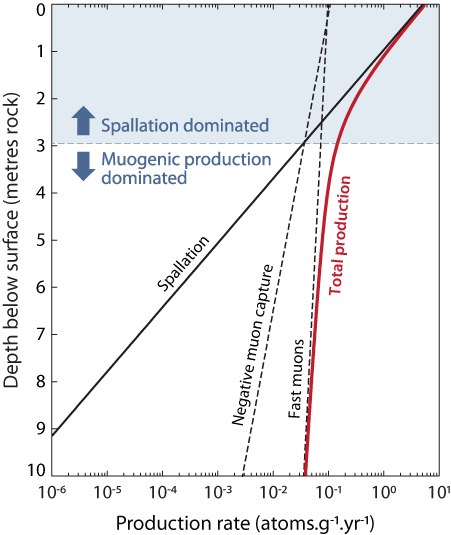 Production Systematics
Production Systematics
Production of cosmogenic nuclides in surface material
Production pathways:
The most common way through which cosmogenic nuclides are formed is via spallation reactions (image below). As the name suggests, in spallation reactions, high-energy neutrons collide with atomic nuclei and sputter off protons and neutrons, leaving behind a lighter nucleus.
The second most common reaction for producing cosmogenic nuclides, and one whose importance increases with depth (see below), is that of negative muon capture. Decelerated negative muons can be captured by the electron shell of atoms, and either decay or be further captured by the nucleus. Captured muons neutralise one proton and deliver energy to the nucleus, the latter facilitating nuclear evaporation. Same as with spallation, the ejection of nucleons as a result of negative muon capture results in a lighter nucleus.
 |  | |
| Spalation reactions produced by cosmic rays as captured in photographic emulsions. Charged particles produce tracks with higher-energy particles inducing weaker tracks than lower-energy particles (from Dunai 2001; doi:10.1017/CBO9780511804519; and based on Powell et al 1959 The Study of Elementary Particles by the Photographic Method, Pergamon 669 pp.) | Negative muon capture reaction on an oxigen nucleus leading to the production of cosmogenic 10Be. |
Production rates:
The production rate of a cosmogenic nuclide is the rate at which it is produced in a given mass of surface material, and is typically reported in atoms g-1 yr-1. Factors that control the rate of nuclide production include the flux of secondary cosmic radiation at a given location, the density of the target material, availability of suitable target nuclei, and the thermodynamic properties of the target nucleus.
16O and 28Si are the primary target elements for 3He, 10Be, 14C, 21Ne, and 26Al, with 14N as an additional target for 14C. 36Cl is produced from potassium, calcium, and chlorine. Each production pathway has its own rate and energy. This means that the more complex the target mineral chemistry, the more difficult it is to calculate an appropriate production rate.
Quartz, with a regular chemical composition and abundant occurrence in the continental crust, is an ideal mineral for 10Be, 14C, 21Ne, and 26Al studies. 36Cl is primarily studied in calcite, pyroxenes and olivines, with the mafic minerals also being used for 3He.
 |
| Relative changes through time in cosmogenic nuclide production rates at sea level in response to changes of the Earth's magnetic field strength. From Dunai 2001; doi:10.1017/CBO9780511804519. |
Scaling production rates:
The flux of secondary cosmic rays is not constant over the globe, because of this, nuclide production rates also change from location to location. The lowest production rates are found at sea-level near the equator, with the highest being found in the polar regions at high elevations. To enable comparison, cosmogenic nuclide production rates are scaled to sea level at high latitudes (SLHL).
Due to the fact that there are numerous ways to frame the equations describing the cascade and attenuation of cosmic rays in the atmosphere, there are multiple competing scaling methods. The differences between the methods can be great. It is therefore important to always report the complete methodology so that results can be recalculated for comparison with other studies.
Additionally, Earth's magnetic field (which is responsible for the latitudinal variations) has changed in strength through time. This presents a challenge for calculating production rates, as rates will have been higher during times of a weak magnetic field, and vice-versa. Variations in Earth's magnetic field strength have been measured using the meteoric 10Be record in ocean sediments and ice cores. This dataset has been used to quantify changes to cosmogenic nuclide production rates for the past 50 kyr.
| Depth dependence: As mentioned abov, the majority (~98%) of cosmogenic nuclides are produced in the upper few meters of the surface through neutron spallation reactions. A small percentage of the cosmic ray flux is composed of higher energy muons which are capable of producing cosmogenic nuclides at deeper depths. The absorption mean free path describes the attenuation of production rates with depth and is reported in g cm-2. The absorption mean free path for any production reaction depends of the size and energy of the secondary cosmic rays and the thermodynamic properties of the target material. The adsorption mean free path length for neutron spallation and muogenic reactions is ~160 g cm-2 and up to 7000 g cm-2, respectively. These correspond to depths of ~0.60 to 14 m in continental rocks. It is however important to note that the attenuation profiles vary conciderably between nuclides, and in the case of 36Cl, can even show increased production rates at shallow depths due to recoil processes. It is therefore important to understand and take into account all the production pathways of a given nuclide when calculating a production rate. |  | |
| Decrease in nuclide production rate with depth (shown here for 10Be). Based on von Blanckenburg 2005; doi: 10.1016/j.epsl.2005.06.030 |
Correction factors:
There are two major corrections for shielding of cosmic rays, topographic and cover. In mountainous settings in which many cosmogenic nuclide studies are carried out, there are substantial topographic obstructions such as mountain peaks and ridges which block a portion of the cosmic ray flux and must be accounted for when calculating nuclide production rates.
Additionally, as mentioned above, cosmic rays are attenuated with depth in any medium in proportion to its density, therefore cover by loess, snow, ice, etc. must be corrected for when determining ages or rates from cosmogenic nuclides.